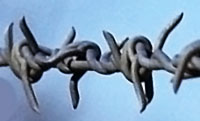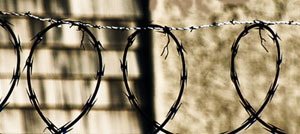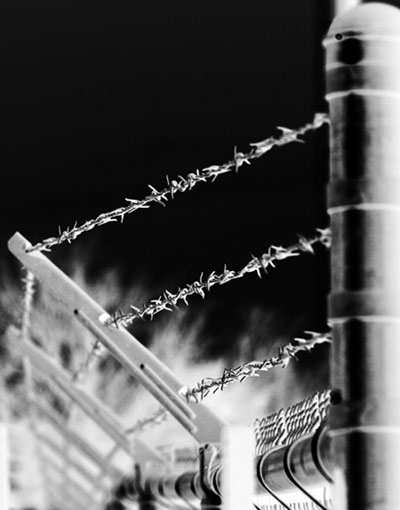Barbed Wire II
by Rob Zaretsky
Today, we turn barbed wire inside out. The Honors College at the University of Houston presents this program about the machines that make our civilization run, and the people whose ingenuity created them.
 When did you last see barbed wire? Chances are as a tattoo on some fellow's bicep. But barbed wire was more than a fashion statement when J.F. Glidden invented it in 1874. The two twisting strands of metal wire, bursting every several inches into spikey knots, soon became a symbol of the modern age on both sides of the Atlantic.
When did you last see barbed wire? Chances are as a tattoo on some fellow's bicep. But barbed wire was more than a fashion statement when J.F. Glidden invented it in 1874. The two twisting strands of metal wire, bursting every several inches into spikey knots, soon became a symbol of the modern age on both sides of the Atlantic.
 Glidden's creation followed the 1862 Homestead Act, which opened the American West. The act encouraged pioneers to settle land on the far side of the Mississippi: 80 acres of land was yours -- free! -- if you were willing to work it.
Glidden's creation followed the 1862 Homestead Act, which opened the American West. The act encouraged pioneers to settle land on the far side of the Mississippi: 80 acres of land was yours -- free! -- if you were willing to work it.
How were you to protect your patch of land, though? Predators like wolves were the least of your problems. There were also disgruntled native Americans who'd been pushed off that same land by a variety of measures: some legal, some not, all unsavory. And there were the cowboys, driving vast herds of cattle across the plains.
Enter Glidden's invention. Easy to transport and erect thanks to its lightness, resistant to the heat thanks to its composition, and dirt cheap to buy thanks to its simplicity, barbed wire seemed heaven sent. And not just to settlers: the American Wire and Steel Company increased its production of barbed wire from 250 tons in 1875 to 135,000 tons in 1901.
The arrival of barbed wire spelled the end of the open range. It also signaled the demise of the cowboy. As played by Kirk Douglas in the movie Man Without a Star, the cowboy became a figure of mythic proportions. Douglas plays the loner Dempsey Rae who thrives on a world without frontiers. But his body, scarred by barbed wire, reveals that this is world already past. At the movie's end, Douglas rides into a sunset: it so happens that the scene is framed by his nemesis, barbed wire.
Within a century, barbed wire had first become a weapon of war, then the symbol of ultimate evil in the Nazi concentration camps. Glidden's invention was turned inside out. Meant originally to keep out, it now kept in. But the "predators" were neither wolves nor cowboys: defined by their politics, race or religion, they weren't even considered human. They were penned inside two rows of electrified barbed wire where, like beasts, they were branded with numbers. And like beasts, they were referred to as kopf (or head) and stück (or piece). But unlike even beasts, they were killed or worked to death.
Unfree and anonymous, the concentration camp inmate embodies the twentieth century reality of totalitarianism. Inmates could achieve liberty only by throwing themselves against the electrified wire. But Dempsey Rae was free; and he symbolizes the nineteenth century American myth of individualism. He pursued liberty by galloping away from barbed wire. Yet in both cases, and in ways J.F. Glidden could never imagine, barbed wire challenges our common understanding of what it means to be human.

I'm Rob Zaretsky, at the University of Houston, where we're interested in the way inventive minds work.
O. Razac, Histoire politique du barbelé. (Paris: La Fabrique, 2000).
For more on barbed wire, see Episode 816. All photos by J. Lienhard.
